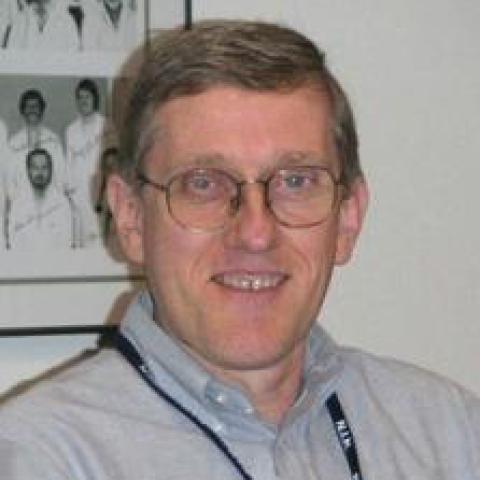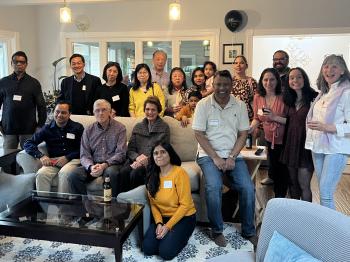
David D. Roberts, Ph.D.
For more than forty years at NIH, David D. Roberts, Ph.D., has explored cellular processes regulated by the protein thrombospondin-1 in vascular and immune cells and developed new therapeutic approaches to treat cancers by shutting off the function of one of its receptors. After 36 years at the NCI, he is announcing his retirement.
Roberts began his scientific career at the Massachusetts Institute of Technology, graduating with a bachelor’s degree in chemistry in 1976. He conducted graduate studies in biological chemistry at the University of Michigan from 1979 to 1983, followed by a postdoctoral fellowship at the National Institute of Diabetes and Digestive and Kidney Diseases (NIDDK). There, he developed his interest in thrombospondin-1, a secreted protein that modulates interactions between cells and their surrounding extracellular matrix. He earned tenure in NIDDK in 1987, where he discovered roles for thrombospondin-1 in the adhesion and migration of cancer cells and in the adherence of red blood cells infected with the malaria parasite Plasmodium falciparum.
In 1988, Roberts became Chief of the Biochemical Pathology Section of the Laboratory of Pathology, where his laboratory continued exploring how thrombospondin-1 controls the formation of blood vessels in tumors (a process called angiogenesis) and regulates the function of tumor-infiltrating immune cells. These studies led to the discovery that thrombospondin-1, through its receptor CD47, can limit the nitric oxide signaling that controls angiogenesis, blood pressure and platelet aggregation. Translational studies revealed the therapeutic potential of inhibiting the expression and function of CD47, to enhance antitumor T cell immunity when combined with radiotherapy, chemotherapy, or CTLA4 immune checkpoint blockade.
What has been the most surprising thing about your scientific career, and what scientific achievements are you most proud of?
Every four years, NIH scientists present our future research plans to the Board of Scientific Counselors along with our accomplishments from the past four years. Looking back over decades of those reports, I found that our most interesting discoveries were generally not foreseen in those plans. I have learned that the most important discoveries arise from focusing our attention on experimental results that do not fit our current hypothesis.
Early in my career, we focused on identifying molecules that interact with thrombospondin-1 and mediate its effects on cell behavior. In addition to identifying three new cellular thrombospondin-1 receptors, our data led us to question the function of other known receptors: CD36 and CD47.
The ability of thrombospondin-1 to inhibit angiogenesis was widely attributed to its interaction with a cell receptor known as CD36. However, we found that thrombospondin-1 inhibited angiogenesis in tissues from mice lacking CD36, whereas angiogenesis was insensitive to thrombospondin-1 in tissues from mice lacking another receptor, CD47. Similarly, the resistance of mice lacking thrombospondin-1 to ischemic injuries and to the death of tissues exposed to ionizing radiation were replicated in mice lacking CD47 but not in mice lacking CD36.
We then found that CD47 was limiting the ability of T cells to kill cancer cells when they are damaged by radiation therapy. We developed therapeutics to inhibit CD47 that enhanced the sensitivity of mouse tumors to ionizing radiation (increasing their long-term survival), the direct killing of target tumor cells by cytotoxic T cells in vivo and the effectiveness of adoptive T cell immunotherapy and CTLA4 checkpoint inhibitor therapy for treating cancers in mice. Our more recent work has extended the role of thrombospondin-1 signaling mediated by CD47 to limiting the antitumor function of natural killer cells in the tumor microenvironment.
How did the intramural environment of CCR and NIH help your research?
The highly collaborative intramural environment connected me with clinical investigators who were interested in biomedical problems that could be addressed using the skills I acquired in my training as a biochemist.
It goes both ways — my clinical colleagues provided me with different perspectives to understand the translational potential of basic research findings. I’ve also had collaborations working with clinical investigators, where I was able to provide them with a basic research approach to advance their clinical studies.
A major translational advance in our research arose when I took a chance hiring a microvascular surgeon, Dr. Jeffrey Isenberg. He wanted to learn research skills to answer his fundamental question, “Why do tissue grafts that initially have healthy blood flow (are well-perfused) survive in some of my patients but ultimately fail in others?” Combining lab studies using cells and tissue explants with instrumentation in the Mouse Imaging Facility, we found that thrombospondin-1 signals through its receptor CD47 limits nitric oxide signaling in poorly perfused tissues. With these findings, we were able to develop therapeutic strategies to block CD47 function that enhances the survival of poorly-perfused tissues in animal models, and we licensed these inventions to a biotech startup in St. Louis.
Another translational application emerged when Dr. Justin Maxhimer, a reconstructive surgeon from Johns Hopkins, joined my lab. He discovered that our CD47 therapeutics protect nonmalignant tissues from losing viability when exposed to ionizing radiation but enhance the ability of ionizing radiation to impede the growth of tumors in those mice. This in turn led to collaborations with CCR immunologists that enabled us to identify CD47 as an immune checkpoint that limits the ability of cytotoxic T cells to kill tumor cells. In developing our translational studies, access to the clinical staff and residents in the Laboratory of Pathology provided opportunities to benefit from their expertise for the evaluation of tissues from our various animal studies.
Do you have any advice for those starting their career here in CCR? What advice do you have for future generations of cancer researchers/physicians?
Think about how your research skills can be applied across medical disciplines. Basic researchers should attend clinical seminars and contemplate what unanswered questions could be addressed using their knowledge and skills. I encourage young investigators to explore the diverse core facilities within CCR and NIH and learn about the available support for patenting and technology transfer that can facilitate the commercial development of your lab discoveries.
What are you looking forward to most in your retirement?
I am looking forward to spending more time outdoors doing photography and having time to catch up on reading that is not related to biomedicine. I am also looking forward to spending more time with family – I have a one-and-a-half-year-old granddaughter and another one on the way.
Dr. David D. Roberts will retire from CCR on May 31, 2024.
